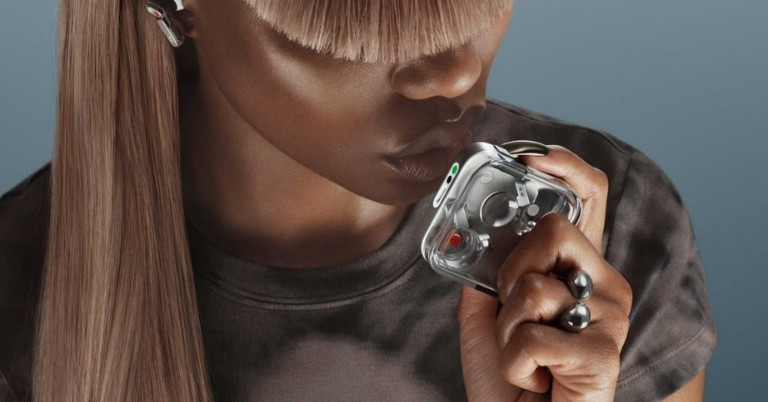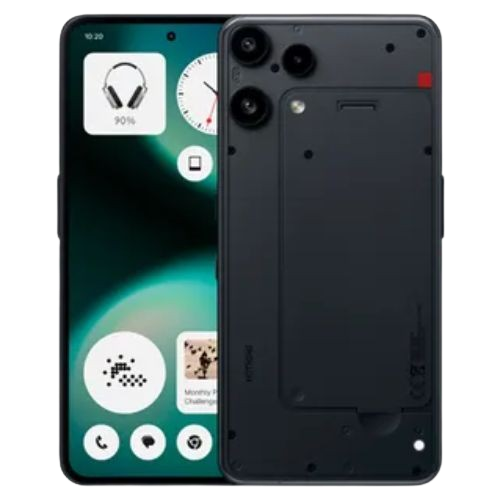No headings found
Nothing has just announced its next flagship TWS earbuds, the Nothing Ear (3). Not to be confused with the naming, these are the successors to last year's Nothing Ear, and not the Nothing Ear (2) from 2023. It comes with a unique "Super Mic" feature, so without further ado, let's take a closer look at everything the Nothing Ear (3) has to offer, including its expected price in Nepal when it launches here later on.
Nothing Ear (3) Overview
A metal case with “Super Mic”
While Nothing's previous TWS earbuds shipped in a plastic case, the Ear (3) has a more premium aluminum case. Although the top half of the case remains plastic to retain Nothing’s transparent look. The change in design also includes a small Metal-Insulator-Metal (MIM) antenna, which the company claims helps improve signal strength.
Available in black and white finishes as always, both the earbuds and the charging case are IP54 dust and splash resistant too.
Like I mentioned before, the Nothing Ear (3) has a unique “Super Mic” feature. So besides the three microphones on each earbuds, its case also has a dual mic setup inside. Users can press the "TALK" button on the case for clearer phone calls in noisy places since Nothing says it can cut out up to 95 dB of ambient noise.

- Here is everything you need to know about Nothing OS 4.0
- Nothing caught using stock photos as Phone (3) camera samples in demo units
- Nothing Phones Price in Nepal [Updated 2025]
Audio quality and battery life
In terms of audio, the Ear (3) upgrades to a larger 12mm dynamic driver (previously 11mm). With this, Nothing says you can expect stronger bass and airy trebles. It also supports spatial audio (but no head tracking) for a more immersive 3D soundstage, while it has AAC, SBC, and LDAC codecs. And thanks to its LDAC support, the Nothing Ear (3) is also capable of streaming hi-res 24-bit audio.
As for noise cancellation, these earbuds can drown out up to 45 dB of ambient noise.
But its battery life honestly seems pretty mediocre. Nothing claims 5.5 hours of music playback with ANC on with the default AAC codec, and that number nosedives to just 3.5 hours if you switch to the high-res LDAC codec. Whereas with the charging case, the Ear (3) can last up to 22 hours with ANC on, or up to 38 hours with ANC off. At least the good news is that a quick 5-minute top-up gives you 1 hour of playback. The Ear (3) takes 70 minutes for a complete refill if you charge it via the USB-C port, and a full 2 hours if you decide to charge it wirelessly.Other features
The Nothing Ear (3) has carried a bunch of features from its predecessor, like in-ear detection to automatically pause media playback when you take either earbud out of your ears. And resume playback once you wear it back. Nothing phone owners can also talk to ChatGPT directly with these earbuds, while it can also read aloud Essential News.
Nothing Ear (3) Specifications:
- Design and build: 30.5 x 21.5 x 20.75 mm, 5.2 gm (per earbud)
- Durability: IP54 dust/water resistant (earbuds + charging case)
- Audio: 12mm dynamic driver, PMI + TPU diaphragm
- Codecs: AAC, SBC, LDAC
- Noise cancellation: Yes (up to 45dB), Transparency mode
- Control: Pinch controls
- Battery capacity: 55 mAh per bud, 500 mAh case
- Playtime: Up to 5.5 hours (ANC on), 22 hours (ANC on) with case
- Charging: USB-C wired, Wireless charging
- Connectivity: Bluetooth 5.4, Dual Connection support
- Other features: Low Lag mode, In-ear detection, Google Fast Pair
- Companion app: Nothing X (Android | iOS)
Nothing Ear (3) Price in Nepal and Availability
In the US, the Nothing Ear (3) will go on sale from September 25 for USD 179. Which is USD 30 more than its predecessor, the Nothing Ear. And when the Nothing Ear (3) arrives in Nepal shortly, we expect its price to be around NPR 30,499.| Nothing earbuds | Price in US (Official) | Price in Nepal (Expected) |
|---|---|---|
| Nothing Ear (3) | USD 179 | NPR 30,499 |
- In the meantime, check out our Nothing Ear (2) review:
Article Last updated: September 18, 2025









